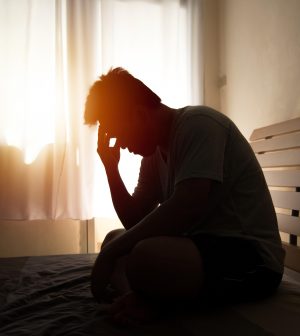- Strengthening Your Relationship: Practical Strategies
- Skip Storing This Everyday Product in the Fridge Door
- Green Tea + B3 Pairing May Boost Brain Health
- Navigating Your Midlife Crisis: Embracing New Possibilities
- City Raccoons Showing Signs of Domestication
- Mapping the Exposome: Science Broadens Focus to Environmental Disease Triggers
- One Week Less on Social Media Linked to Better Mental Health
- Your Brain Changes in Stages as You Age, Study Finds
- Some Suicide Victims Show No Typical Warning Signs, Study Finds
- ByHeart Formula Faces Lawsuits After Babies Sickened With Botulism
Americans Who Are Deaf Can Now Use 988 Suicide Helpline

MONDAY, Sept. 11, 2023 (HealthDay News) – The U.S. government’s 988 Suicide and Crisis Lifeline is expanding its reach to help more people.
The crisis line has now launched services in American Sign Language (ASL) to help callers who are deaf or hard of hearing.
The ASL services were launched on Friday, according to the U.S. Department of Health and Human Services.
“Individuals across America who use ASL as their primary language can now readily access the support they need during a mental health crisis,” Health and Human Services Secretary Xavier Becerra said in an agency news release. “With the introduction of 988 ASL services, we are taking a significant stride forward in providing inclusive and accessible support for the deaf and hard-of-hearing community.”
The services use a videophone device that transmits video and audio. It can be reached by clicking “ASL Now” on 988lifeline.org. Callers can alternatively call 1-800-273-TALK (8255) but will soon also be able to directly dial to 988 by videophone.
“After years of advocacy to ensure that 988 is available to everyone not only through voice calls, but also texting and video for sign language users, the National Association of the Deaf (NAD) is thrilled that the 988 Suicide & Crisis Lifeline is now available to use through video calls in sign language,” said NAD CEO Howard A. Rosenblum. “We encourage anyone going through a crisis or thinking about suicide to contact 988 in any way preferred — voice, text, or sign language.”
The new move is part of an ongoing effort by the HHS’s Substance Abuse and Mental Health Services Administration (SAMHSA) to add accessibility to behavioral healthcare.
An earlier update added Spanish-speaking services by text and chat.
“We’re talking about mental health in a way that we have not historically talked about it,” said Monica Johnson, director of the 988 & Behavioral Health Crisis Coordinating office at SAMHSA.
The 988 Suicide and Crisis Lifeline was launched last year for anyone who is experiencing a mental health crisis, emotional distress or contemplating suicide. It is an evolution from the former National Suicide Prevention Lifeline.
Making it possible to reach help by dialing only three digits was meant to make it easier to remember.
The lifeline is a network of 200-plus local call centers, with an investment of nearly $1 billion by the Biden administration. Funds go directly to states, territories and tries to fund crisis counselors, according to HHS.
This past year, the lifeline has taken about 5 million calls, texts and online chat messages.
Still, more work to publicize the new service may be needed: About 82% of 2,000 people polled by the National Alliance on Mental Illness in a poll released in July said they had not heard of the lifeline.
More information
The National Institute of Mental Health has more on suicide prevention.
SOURCE: U.S. Department of Health and Human Services, news release, Sept. 8, 2023
Source: HealthDay
Copyright © 2025 HealthDay. All rights reserved.










